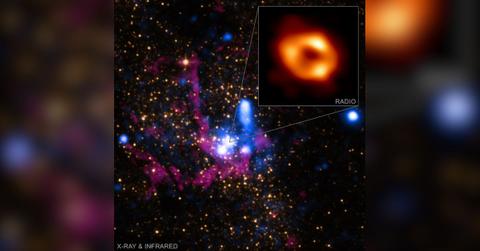Lighting up the Universe: Einstein's 'Gravitational Lasers' Theory More Than Science Fiction, Study Reveals

Scientists have believed for decades that black hole atoms can be found throughout the universe. They have also determined that black holes do emit gravitational waves that manifest as ripples in the fabric of space-time.
New findings suggest Albert Einstein's concept of "gravitational lasers" firing from black holes might be more than just theoretical speculation.
Recent insights propose that gravity, in the elusive form of dark matter, could potentially be harnessed to produce a cosmic laser beam.
Physicist Jing Liu from the University of Chinese Academy of Sciences in Beijing has penned a paper shedding light on this intriguing possibility.
In his work, titled "Gravitational laser: the stimulated radiation of gravitational waves from the clouds of ultralight bosons," Liu explores how Einstein's predictions of stimulated radiation and gravitational waves could materialize within gravitational atoms, comprising Kerr black holes enveloped by boson clouds formed through superradiance.
This paper underscores the notion that ripples in the fabric of space-time could coalesce into "gravitational lasers," shooting out from black holes in various directions throughout the cosmos.
Liu suggests that gravity might indeed be redirected into a cosmic laser beam, contingent upon the existence of a specific model of dark matter.
LiveScience reports that this model revolves around axions, hypothetical ultralight particles ubiquitous in the universe, possessing both wave and particle characteristics. These axions, with their wave-like attributes, could be ensnared by black holes.
For decades, scientists have believed the presence of black hole atoms scattered across the universe. They've also established that black holes emit gravitational waves, manifesting as ripples distorting space-time.
- Alien Invasion? Harvard Expert Claims Meteor Strike in Pacific Ocean May Have Extraterrestrial Origins
- Cosmic Conquest: A.I. Predicts Aliens Set to Infiltrate Human Minds, Manipulate Organic Lifeforms on Earth
- Alien Objects on Earth? Harvard Physicist Says Mysterious Fragments Found in Ocean Come From Outside Solar System
According to Liu, if the requisite conditions align — with accurate gravitational waves emitted by the black holes — axions encircling these cosmic behemoths could trigger a cascade, like a laser beam.
This theoretical scenario, however, hinges on near-perfect conditions, making the phenomenon exceptionally rare. Moreover, capturing these gravitational lasers poses a challenge, given their random trajectories away from Earth.
Never miss a story — sign up for the Front Page Detectives newsletter. Be on the scene the moment news breaks.
Nevertheless, these elusive phenomena could potentially be observed by forthcoming gravitational wave observatories and other advanced detection methods.
As Liu concludes, "Superradiant instabilities can be induced by various astrophysical objects, including stars, neutron stars, boson stars, and BH binaries. These systems may also give rise to stimulated GW radiation, revealing a broader range of phenomena that we leave for future exploration."
Become a Front Page Detective
Sign up to receive breaking
Front Page Detectives
news and exclusive investigations.
